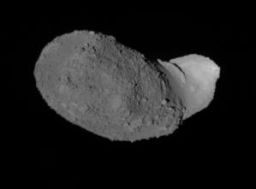Emily Lakdawalla • Oct 10, 2007
DPS: The Yarkovsky, O'Keefe, Radzievskii, and Paddack (YORP) effect
On Monday at the Division of Planetary Sciences meeting in Orlando there was an entire oral session devoted to YORP, which stands for Yarkovsky, O'Keefe, Radzievskii, and Paddack, all of whom studied the effects of solar radiation pressure on small bodies in the solar system. The YORP effect is a change in the rotation rate or obliquity (the angle that the rotation axis makes to the orbital plane) of a body caused by solar radiation pressure -- the same force that drives the solar sail -- and the delayed re-radiation of solar rays. These forces are negligible for planets and larger asteroids, but the smaller the asteroid, the more significant these forces become. (A related phenomenon, the Yarkovsky effect, has to do with solar radiation pressure pushing asteroids in such a way that the shapes of their orbits change; YORP specifically refers to changes in spin states and obliquity.)
I missed the opening talks in the session that would have given me an overview of YORP processes (I was in the concurrent session on Cassini at Iapetus), but later in the session Bill Bottke gave a useful overview of how YORP affects the evolution of the spins and orbits of asteroids. He said that YORP can spin up asteroids a lot. They can spin so fast that if they are rubble piles, they will "shed mass," which, he said, is one way of creating asteroid satellites. But the shed mass carries with it a disproportionate quantity of the spun-up asteroid's angular momentum, so the part of the asteroid that's left behind may actually be rotating more slowly. YORP can also act directly to decrease an asteroid's spin, causing it eventually to enter a tumbling rotation state. Eventually, the asteroid may tumble into an orientation where YORP may spin it back up again. This process can be cyclic, which explains the distribution of asteroid spins. If you start with a bell-curved distribution of spin speeds, YORP will tend to move asteroids toward extreme spin rates, either very slow or very fast; but the cyclic nature of the effect means it's also acting on these fast and slow rotators to slow them down or speed them up, moving asteroids from the extremes back toward the middle of the distribution. The end result is a fairly flat distribution, where there are roughly as many slow rotators as intermediate rotators as fast rotators. Incidentally, I notice that Bottke is one of those rare researchers who actually posts PDF copies of all his recently published papers on his website; check them out.
The first asteroid on which this was directly detected was (54509) YORP, until recently known as 2000 PH5, which has now been named for the four scientists who developed the theory of the YORP effect. (It seems to me that each of those guys should have gotten his own asteroid; it's not like there aren't enough asteroids to go around.) I showed up in the session just in time for the paper on Itokawa, only to find out that, after correcting an error in their analysis, Kitazato had to apologize to the room and say that they had actually not detected any change in spin rate, which implies that the YORP effect on Itokawa is smaller than 10% of its theoretically predicted value. It appears that, in general, when astronomers search for these direct detections, they are finding the effect to be much smaller than theory predicts. Apparently additional studies are in process of several other bodies (2004 DC, 200 DP107, and 1991 VH) on which workers hope to bag more direct detections of YORP effects.
Support our core enterprises
Your support powers our mission to explore worlds, find life, and defend Earth. You make all the difference when you make a gift. Give today!
Donate

 Explore Worlds
Explore Worlds Find Life
Find Life Defend Earth
Defend Earth


